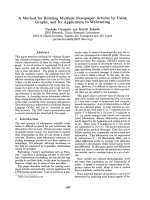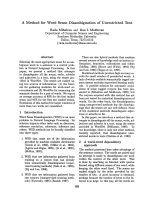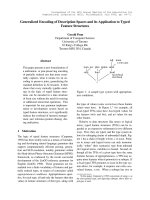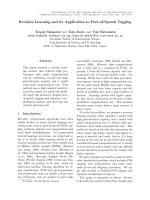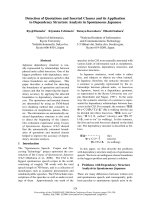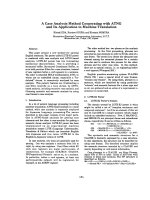A method for 3d nano focusing of optical energy and its application to the surface enhanced raman spectroscopic study of protein 1
Bạn đang xem bản rút gọn của tài liệu. Xem và tải ngay bản đầy đủ của tài liệu tại đây (3.52 MB, 129 trang )
A Method for 3D Nano-focusing of
Optical Energy and its Application to
Surface Enhanced Raman
Spectroscopic Study
by
Kiang Wei Kho
(2009)
A Method for 3D Nano-focusing of
Optical Energy and its Application to
Surface Enhanced Raman
Spectroscopic Study
by
Kiang Wei Kho
SUBMITTED IN PARTIAL FULFILLMENT OF THE REQUIREMENTS FOR THE
DEGREE OF DOCTOR OF PHILOSOPHY
AT
NATIONAL UNIVERSITY OF SINGAPORE
Supervisors:
Prof. Frank Watt, National University of Singapore
Prof. Malini C Olivo, National University of Singapore
Prof. Shen ZeXiang, Nanyang Technological University of Singapore
Table of Contents
Acknowledgements
Synopsis
Acknowledgements
Glossary
List of Figures
List of Tables
Introduction
Chapter 1 Protein Layers
Page
1.1
A Brief Discussion on Protein Layers Adsorbed at Solid-Liquid Interface
1
1.2
Study of Solid-Supported Protein Layers
2
1.2.1
Electronic Spectroscopy
3
1.2.2
Ellipsometry
4
1.2.3
Atomic Force Microscopy
5
1.2.4
Computer Simulation
6
1.2.5
Vibrational Spectroscopy
7
1.3
Surface-Sensitive Raman Spectrocopy: A New Paradigm for Protein-Layer Studies 9
1.4
Objective of Current Study
11
Chapter 2 General Theory of Enhanced Raman Scattering and its Experimental
Verifications
2.1
General Theory of Raman Scattering
13
2.2
Enhanced Raman Scattering
13
2.2.1
Chemical Raman Enhancement
14
2.2.2
Electromagnetic Raman Enhancement
16
i
2.3
Electromagnetic Raman Enhancement through Nano-focusing of Optical Energy
17
2.3.1
Nano-focusing of Optical Energy by Dielectric Microspheres
17
2.3.2 Nano-focusing of Optical Energy by Noble Metallic Nano-particles
18
2.4
Enhanced Raman Scattering by Dielectric Microspheres
21
2.5
Enhanced Raman Scattering by Noble Metal: Surface Enhanced Raman Scattering
(SERS)
2.5.1
21
Evidence of SERS: Excitation- and Raman-wavelength Dependence of SERS from
Metallic Nano-particles
2.5.2
Evidence of SERS: Dependence of Enhanced Raman Intensities on the Gap
Separation within a Metallic Dimer
2.5.3
34
Evidence of SERS: Polarization Dependence of Enhanced Raman Intensities from
Anisotropitc Metallic Substrates
2.6
25
38
Comparison of the Overall Enhancement Attainable by Above two Nano-focusuing
Schemes
2.7
43
Conclusion
44
Chapter 3 Limitations in Conventional Surface Enhanced Raman Scattering
3.1
Limited SERS Hot-spot Sizes
46
3.1.1
Distance Dependence of SERS from Si-Au-Shell-Core Structures
50
3.1.1.1 Fabrication of Silica-Shell Au-Core (Si-Au) SERS Nano-particles
51
3.1.1.2 Raman Microscopy System
52
3.1.1.3 TEM Analysis of Si-Au
54
3.1.1.4 SERS Scattering from Si-Au
56
3.1.1.5 Preparation of Silica Film graom on Au-Film Overcoated Nano-spheres (AuFON)
array
60
3.1.1.6 Distance Dependence of SERS from Au-Film Overcoated Nano-spheres (AuFON) 61
ii
3.1.2
SERS Substrates for the Study of Protein Layer
63
3.2
Temporal Variation sin SERS signals as a Resulf of Surface Plasmonic Heating
65
3.2.1
Irreversible Signal Loss
65
3.2.1.1 Introduction
65
3.2.1.2 Experimental Procedure
67
3.2.1.3 Temporal Changes in SERS Signals
68
3.2.1.4 Changes in the Orientation or Chemical Structure of the Analyte Molecule
72
3.2.1.5 Desoprtion of Analyte Molecules
75
3.2.1.6 Themal-induced Lateral Diffusion of Au Nano-particles
79
3.2.2
A Stable substrates for Reproducible Results
86
3.3
Effects of SERS-active Metallic Sandwiches on Protein Structure
87
3.3.1
Structural Changes in Cytochrome-c Sandwiched in Between Nano-particles
87
3.3.1.1 Agarose Gel Analysis
88
3.3.1.2 TEM Analysis
89
3.3.1.3 Circular-Dichroism Analysis
90
3.3.1.4 SERRS of Cytochrome-c
92
3.3.2
Structural Study of Protein Adsorbed on SERS substrates
94
3.4
Conclusion
98
Chapter 4 Electromagnetic Theory of 3D Nano-focusing of Surface Plasmon Polariton
and its Application to Surface Enhanced Raman Scattering (SERS)
4.1
General Theory of Propagating Surface Plasmon on Smooth Surfaces
100
4.2
Excitation and Evidence of Propagating Surface Plasmons
105
4.3
Exciting Propagating Surface Plasmons Optically
108
4.3.1
Exciting Surface Plasmons via Kretschmann-Raether Configuration
108
4.3.2
Exciting Surface Plasmons via Otto Configuration
114
iii
4.4
Surface Plasmon Polariton Assisted Surface Enhanced Raman Scattering on
Ultrasmooth Metal Surface
4.5
118
Electromagnetic Theory of Semi-infinite Metal Containing Dielectric
Nano-cavities
121
4.5.1
Maxwell Formulation
122
4.5.2
Computational Results
123
4.5.2.1 Field Enhancement by Isolated Dielectric Spherical Nano-cavities of Different
Sizes
124
4.5.2.2 Field Enhancement by Isolated Dielectric Nano-cavities of Different
Aspect-Ratios
128
4.5.2.3 Influence of the Dielectric Constant of an Isolated Dielectric Non-spherical Nanocavitites on the Field Enhancement
130
4.5.2.4 Influenece of the Cavity Depth on the Field Enhancement
132
4.5.2.5 Closely-packed Peridoic Arrays of Embedded Dielectric Nano-cavities
134
4.5.3
Discussion
137
4.6.1
SPP-Assisted Surface Enhanced Raman Scattering on Ultrasmooth Metal Surface
with Embedded Dielectric Nano-cavity
4.7
144
Conclusion
146
Chapter 5 Fabrication of Dielectric Spheroidal Nano-cavity Embedded Substrate for
Surface Enhanced Raman Scattering
5.1
Fabrication Methodology
148
5.2
Fabrication of Dielectric Nano-cavity Embedded Metal Substrate
153
5.2.1
Formation of Ultrasmooth Metal Surface on a Mica Template
153
5.2.2
Ar+-Assisted Ion Beam Deposition of Au on Atomically Smooth Mica substrate
153
5.2.3
Fabrication of Nano-particle Monolayers
154
iv
5.2.3.1 Functionalization of Au surface
155
5.2.3.2 Fabrication of Spherical Nano-particle Monolayers by Convective Assembly
156
5.2.3.3 Fabrication of Oblate Nano-particle Monolayers by Convective Assembly
159
5.2.4
Electrodeposition
163
5.2.5
Attachement of Plated Samples to Solid Support and Peeling of Mica Template
163
5.3
Characterization of the nano-cavity Embedded Au Substrates
164
5.3.1
FE-SEM Cross-sectional Imaging of the Electroplated Spherical and Oblate Nanoparticle Array
164
5.3.2
Characterization of Exposed Au Surface by FE-SEM and AFM
167
5.3.3
Resistance Test Toward Thiol Functionalization and Buffer Solutions
168
5.3.4
Scanning Near-Field Imaging of Nano-cavity Embedded Au Substrates
170
5.4
Conclusion
173
Chapter 6 Dielectric Nano-cavity Embedded SERS Substrates in the Study of a Model
Protein
6.1
Setup of Measurement Systems
6.1.1
PDMS ATR Device for SERS and Surface Plasmon Response (SPR)
Measurements
174
175
6.1.2
Setup for Measuring SPR Response of the Nano-cavity Embedded Au Substrates 182
6.1.3
Setup of Total Internal Reflection Raman System: Otto Setup
184
6.2
Preparation of Protein Sample and SERS Substrates
185
6.2.1
Functionalization of Nano-cavity Embedded Au Substrates
185
6.2.2
Preparation of Periodic Ag-Film Overcoated Nano-spheres Monolayer
186
6.3
SPR Response Nano-cavity Embedded au Surfaces
186
6.4
SERS from Nano-cavity Embedded Au Surfaces
189
6.5
SERS of a Protein Sample: Cytochrome-c
194
v
6.6
Conclusion
202
Chapter 7 Conclusion and Future Direction
Appendix I
Appendix II
Appendix III
Appendix IV
Appendix V
Appendix VI
Appendix VII
Conference Abstracts and Publications
References
vi
Synopsis
Monolayers of large protein molecules self-assembled on a solid platform play a
profoundly significant role in many fields ranging from biophysical sciences to biology.
Study of such a protein system permits insights into the interplay between protein–protein
interactions, protein-surface interactions, as well as protein conformational changes, and thus
allows for mechanistic understanding of a protein layer. Unfortunately, conventional
techniques such as X-ray crystallography and Nuclear Magnetic Resonance are not stuited for
this purpose. Hence, any progress made in advancing the technique for analyzing planar
macromolecular systems is highly desirable. The current thesis describes the development of
a photonic device capable of nano-focusing light energy, and demonstrates its application to
the Surface Enhanced Raman Spectroscopic (or SERS) study of a macromolecular layer.
Chapter 1 provides a background on protein layers (PLs). Subsequently, various
techniques previously used for PLs are introduced. Their operating principles and limitations
are discussed. This is followed by a brief description on techniques previously developed for
protein layer studies. Lastly, the potential of a unique surface sensitive Raman scattering
phenomenon known as the Surface Enhanced Raman Scattering (SERS) in probing
conformational changes in molecular layers adsorbed on an interface is discussed. In
particular, it is stressed that conventional SERS provides meaningful Raman spectra only if
small adsorbates (< 2 nm) are used. This greatly limits its value in studying layers of
macromolecules such as proteins, whose sizes are often larger than 2 nm. The objective of
this study is thus to address this issue.
vii
Chapter 2 describes the general quantum theory of SERS. It can be shown that nanofocusing of light fields by a roughened metal surface can lead to intensified surface fields
capable of enhancing the Raman scattering of adsorbates. Experimental evidence of metal
surface induced SERS are then introduced, and shown to conform to the theory.
Chapter 3 points out the limitations in conventional SERS. In particular, a technique
is developed to allow for measurements of the spatial extension of the SERS fields on
roughened surface. Additionally, various artifacts brought about by the SERS-active metal
surface are stressed.
Chapter 4 introduces the concept of surface-plasmon polariton assisted SERS on a
smooth metal surface. Subsequently, the use of a smooth metal surface with embedded
dielectric spheroidal nano-cavities for SERS study is proposed. Through a rigorous analysis
of the Maxwell equations obtained for such a system, it is shown that nano-focusing of a light
field is also possible on a smooth metal surface. This is ascribed to a compression of the
propagation vector of the surface plasmon polariton as a result of the embedded nano-cavity
underneath the surface.
Chapter 5 details the fabrication of the cavity system proposed in Chapter 4.
Different substrates bearing embedded nano-cavities of different shapes were fabricated.
Characterizations of the final substrates are given.
Chapter 6 describes the various experimental setups for carrying out SERS
experiments with the dielectric cavity-embedded substrates. Comparison of results with
theoretical predictions is discussed. Lastly, SERS spectra of a test protein, Cytochrome c (2.9
viii
nm) self-assembled on the smooth metal surface of the cavity-embedded substrates and on a
roughened metal surface were acquired and compared. Results from these experiments
suggest a potential application of the current proposed cavity system in macromolecular layer
studies.
The final chapter gives an overall conclusion of the research project. Both the results
of the fabrication and characterization of the cavity systems are evaluated. In addition, the
prospective developments of the systems as well as their contributions to the understanding
of protein layers are also presented.
ix
Acknowledgements
The three names that deserve to appear in the first sentence on this page are Prof.
Malini Olivo, Prof. Shen ZeXiang, and Prof. Frank Watt, without whom this thesis would not
have been possible.
Life is not always fair; it does not always give you what you want; dreams are not
fulfilled as soon as you want them to; but these are not as important as perseverance. The
journey I have embarked on to reach where I am today, has taught me to persevere.
First and foremost, I would like to express my sincere gratitude to my supervisor Prof.
Malini Olivo, for her constant encouragement and dedication as a supervisor. I would also
like to thank her for providing valuable research input and having “put my research career
back on track” by allowing me to pursue my PhD.
I am grateful to Prof. Shen ZeXiang for accepting me as his PhD student, and for his
constant suggestions and encouragement. Thanks are also due to Dr. Ni Zhenhua, Mr.
Johnson Kasim, Dr. Fan Haiming, Mr. You Yu Meng, Ms. Wong Chon Pei, and Ms. Ma Yun
for not only their interesting discussions and inspiring ideas but also for their friendship and
help.
Much of the research involved in this PhD project has greatly relied on collaborations
with many scientists from both National University of Singapore (NUS) and Nanyang
Technological University of Singapore (NTU). I would like to express my greatest gratitude
to Prof. Subodh Gautam Mhaisalkar of NTU for his very generous support and for loaning of
the equipment essential for the completion of this project, namely TEM, FE-SEM, Au
sputterer, and oven. Thanks should also be given to Ms. Koh Zhen Yi Karen for having had
to wake up at 5 in the morning to prepare substrates. I am also indebted to Ms. Iman Ahmad
and Dr. Srinivasan Madhavi for their assistance in preparing Au substrates. I would also like
to express my deepest appreciation to my colleagues at Laboratory of Optical Imaging and
Photodynamic Therapy in the National Cancer Centre, namely Dr. Patricia Thong, Ms.
Ramaswamy Bhuvaneswari, Mr. William Chin and Ms. Lucky Sasidharan, and also to
colleagues from the Singapore BioImaging Consortium (SBIC) laboratory, namely Dr.
Praveen Thoniyot, Dr. Dinish U.S. and Mr. Chit Yaw Fu for their support and help in
proofreading this thesis. Special thanks are due to Prof. Frank Watt of NUS for his support.
x
Lastly, and most importantly I would like to thank the Physics Department, National
University of Singapore, for providing me the opportunity to pursue my studies, and to the
Biomedical Research Council (BMRC) for financial assistance, and also to the Singapore
Millennium Foundation (SMF) for the millennium scholarship.
Yours,
Kiang Wei Kho
2009
xi
Glossary
PL
Protein Layer
XC
X-ray Crystallography
NMR
Nuclear Magnetic Resonance
CD
Circular Dichroism
FRET
Fluorescence Energy Transfer
IRA
InfraRed Absorption
RS
Raman Spectroscopy
SSIE
Site-Specific Isotope Editing
VS
Vibrational Spectroscopy
BSA
Bovine Serum Albumin
AFM
Atomic Force Microscope
MC
Monte Carlo
SERS
Surface Enhanced Raman Spectroscopy
CM
Chemical
EM
Electromagnetic
FWHM
Full Width at Half-Maximum
SPR
Surface Plasmon Resonance
SP
Surface Plasmon
PNS
Poly-styrene Nano-sphere
EF
Enhancement Factor
OEF
Overall Enhancement Factor
CV
Crystal Violet
CW
Continuous Wave
BR
Band Ratio
BCM
Boundary Charge Method
Bi-BSA
Biotinylated Bovine Serum Albumin
SA
Streptavidin
BPE
trans-1,2-bis-(4-pyridyl)ethylene
Cyt-c
Cytochrome c
TEM
Transmission Electron Microscopy
xii
MPTMS
3- mercaptopropyltrimethloxisilane
AuFON
Au-Film Overcoated Nano-spheres
DDA
Discrete Dipole Approximation
LLT
Liquid Layer Thickness
SPRH
Surface Plasmon Resonance Heating
AIG
Average Inter-particle Gap
DDL
Diffuse Double Layer
SERRS
Surface Enhanced Raman Resonance
Spectrodscopy
LSP
Localised Surface Plasmon
PSP
Popagating Surface Plasmon
CSD
Cavity-to-Surface Distance
AR
Aspect Ratio
STM
Scanning Tunneling Microscope
SC
Spin-cating
CA
Convective Assembly
APTMS
3- aminopropyltrimethloxisilane
3 – MPA
3 – mercaptopropionic acid
PVA
Polyvinyl Alcohol
PDMS
Poly-dimethylsiloxane
FE-SEM
Field-Emission Scanning Electron Microscope
THF
Tetrahydrofuran
SAM
Self-Assembled Monolayer
RMS
Root Mean Square
SNOM
Scanning Near-Field Optical Microscope
ATIR
Attenuated Total Internal Reflection
11 – MUA
11 – Mercaptoundecanethiol
1 – OT
1 – Octanethiol
SDS
Sodium dodecyl sulphate
NA
Numerical Aperture
IMRE
Institute of Material Research and Engineering
FDTS
1H,1H,2H,2H-perfluorodecyl-trichlorosilane
CSERSS
Conventional SERS substrate
AgFON
Ag-Film Overcoated Nano-spheres
xiii
AuFON
Au-Film Overcoated Nano-spheres
List of Figures
Chapter 1
Page
Fig. 1. (left-most diagram) Rayleigh scattering, (middle diagram) Infrared
Absorption, (Right-most diagram) Stoke Raman scattering.
7
Chapter 2
Fig. 1. Chemical Raman enhancement. (a) An electronic transition from the HOMO state to
an intermediate metal state. (b) An electronic transition from a metal intermediate
state to the LUMO state.
Fig. 2. Nano-jet from a dielectric sphere with R = 5λ. Ref. (71)
15
18
Fig. 3. Normalised intensity map of light field around nano-spheres. (a) 40 nm Au nanospheres. (b) 40 nm polystyrene nano-spheres. Refractive index for Au is 0.2 + i3.4
(73) , and that for polystyrene is 1.4. It is assumed that these spheres are immersed in
water with index of 1.33. A red and a black arrow in the figure indicate the
polarization and propagation direction of the incident wave respectively.
20
Fig. 4. Polar plot of field component around a 40-nm Au nano-sphere. Refractive index for
Au is 0.2 + i3.4 (73), and that for polystyrene is 1.4. It is assumed that these spheres
are immersed in water with index of 1.33. A red and a black arrow in the figure
indicate the polarization and propagation direction of the incident wave respectively.
23
Fig. 5. Plot of maximum OEF achievable with various particle sizes. Refractive index for Au
is based on Ref. (70), and that for polystyrene is 1.4. It is assumed that these spheres
are immersed in water with an index of 1.33. Each point on the curve corresponds to
xiv
an OEF value evaluated for a given particle size under a resonance condition.
24
Fig. 6. Raman spectra derived from 0.1-µM CV solution. (a) Enhanced Raman spectrum
obtained with 40-nm Au nano-particles. (b) Un-enhanced Raman Spectrum.
Collection time = 10s. Excitation wavelength = 633 nm. Inset: molecular structure of
crystal violet.
26
Fig. 7. Normalised SERS intensities of CV from particles of different sizes. Note that the
dashed line is a therotical curve derived from Mie’s theory, and the experimental
points are displayed as circles. Error bars = 10 %.
28
Fig. 8. Normalised UV-Vis spectra of various Au colloids. Note the red-shift in the plasmon
peak as the particle size increases. The excitation lines of 514 nm and 633 nm are
indicated by the vertical dashed lines.
29
Fig. 9. Effect of Stoke Raman Shift on the excitation profiles. Excitation profiles are shown
as dark curves, and extinction curves in blue (a) Profile of the 1575 cm-1 vibrational
mode of benzenethiol. Distance between λSPR and excitation peak λex = 734 cm-1. (b)
1081 cm-1 vibrational mode, shift = 569 cm-1. (c) 1009 cm-1 vibrational mode, shift =
488 cm-1. Ref. (80).
30
Fig. 10. (Top panel) SERS specrta of CV derived from Au nano-particles of different sizes.
Note that all spectra are normalised to the first peak at 442 cm-1. Each spectrum is
offset vertically for clarity. Integration time = 10s.
32
Fig. 11. (Top panel) Band-ratio versus particle size. Curves are normalised at 150 nm.
(Bottom panel) Band-ratio versus particle size as calculated based on Maxwell
theory.
33
xv
Fig. 12. 40-nm dimer with intense Plasmon field within a 5-nm inter-particle gap. Excitation
polarization is parallel to the dimer axis. Dark arrow indicates propagation direction,
while red arrow incident polarization.
35
Fig. 13. Field strength |E| along a line through the centre of the 40-nm Au dimer shown in
Figure 12. Incident polarization is assumed to be along the z-axis with an electricfield strength of 1 V/m
35
Fig. 14. Theoretical extinction spectra of 40-nm Au dimer with different gap separations (a).
Incident polarization is assumed to be along the z-axis. The 633 nm excitation laser
is marked with a dashed line.
Fig. 15. Temporal fluctuations of SERS signals from a dimmer
36
36
Fig. 16. (a) The initial on-axis Rayleigh scattering resonance of a nano-particle dimer
corresponding to an inter-nano-particle distance of 2.3 nm. (b) the particles has
moved apart by 1 nm, which becomes apparent as a blue-shift of the on-axis dimer
resonance by 50 meV. (b and d) A different dimer (1.1 nm) was probed, where the
particles move closer by 0.6 nm as can be deduced from a red shift of the resonance
by 130 meV.
38
Fig. 17. |E|2 map across a plane through the centers of Au ellipsoid (120 nm: 50 nm) as
calculated by BCM simulation. Whit double-headed arrows indicate incidence
polarization direction.
40
Fig. 18. (a) Plot of |Ex,y,z|2 versus polarization angle for two different locations on the Au
ellipsoid. E1 corresponds to field intensity at the apex of the particle, while E2 side
of the particle. (b) Plot of normalized OEF versus polarization angles as calculated
by BCM simulation. Es represents the local field perpendicular to the particle
surface. The dielectric constant of the surrounding medium is 1 (air), while that of
xvi
the particles is based on the experimental data of Johnson and Christy (83).
Excitation wavelength = 633 nm.
41
Fig. 19. Raman spectra of the BPE recorded for two polarization directions of the incident
laser, parallel and per-pendicular to the major axis. Ref. (80).
42
Fig. 20. (Right panel) Experimental data obtained from (83).
42
Fig. 21. Definition of hot-spot volume for (a) Nano-jet (from Ref. 67) and (b) metal Nanoparticle.
44
Chapter 3
Fig. 1. Normalised EF distribution around spherical Au nano-particles with (a) 40 nm, (b) 80
nm, and (c) 150 nm in a diameter. Red arrows indicate z-polarisation, while white
arrows represent propagation direction. Refractive index for Au is taken to be 0.2 +
i3.4, while the surrounding medium was assumed to be 1. The EF distribution is
v
calculated based on the fields E around the nano-particles evaluated via Mie’s
theory.
47
Fig. 2. Normlised EF distributions around crevices between nano-protrusions in a rough
surface. Red arrows indicate the incident direction. Excitation wavelength is assumed
to be 633 nm. The roughened surface shown in (a) was fabricated by coating a 200nm Au film over periodically packed polystyrene nano-spheres (400 nm). (b)
Electromagnetic calculation of EF distribution between Au nano-protrusions. The
polarization is assumed to be horizontal, i.e. in parallel to the plane of the image.
Nano-protrusions are modeled as 20 nm metal nano-spheres, with a refractive index
for Au taken to be 0.2 + i3.4, while that for the surrounding medium was assumed to
be 1.
49
Fig. 3. Fabrication of Silica-Shell Au-Core nano-particles.
52
Fig. 4. Raman microscopy system for SERS measurement. Inset: Sample configuration.
54
xvii
Fig. 5. Growth of Silica Shells around Au particles. Top panel: 40 nm Au core, Middle panel:
80 nm Au core, Bottom panel: 150 nm Au core. Silica shells are indicated
by arrows.
55
Fig. 6. CV SERS intensities derived from SiO2-Au samples with Au core-size of (a) 40 nm,
(b) 80 nm, and (c) 150 nm.
58
Fig. 7. SERS intensities versus SiO2 thickness for 40, 80, 150 nm Au core sizes.
d
Fig. 8. Normalised EF as calculated based on 1 +
R
59
−12
for 40, 80, 150 nm Au nano-
particles.
60
Fig. 9. Normalized SERS intensities versus various thicknesses of SiO2 film coated over
AuFON.
Fig. 10. Normalized EF versus various thicknesses of SiO2 film coated over AuFON.
62
63
Fig. 11. Normalized EF distributions around two dimer consisting of 40-nm Au nanoparticles with (a) 3-m and (b) 5-nm inter-particle gaps. These maps were calculated
by modeling each nano-particle as a dipole.
65
Fig. 12. Sample configuration. Closely-packed 15-nm Au nano-particles array was deposited
on a Super-Frost glass slide. Photo: A AFM scan of the colloidal film.
67
Fig. 13. Temporal decay of SERS signals derived from 1 µM CV.
68
Fig. 14. Integrated Raman intensity decay from two CV samples.
69
Fig. 15. Raman intensity decay from two CV samples.
71
Fig. 16. Comparison of normalized SERS spectra measured at 40-s and 240-s time points for
different scan ranges: (a) 565 – 920 cm-1; (b) 930 – 1,285 cm-1 ; (c) 1,290 – 1650 cm-1
Spectra acquired at t = 240 s has been shifted up-ward for clarity.
74
Fig. 17. Chromatography and MS data for heat-treated and non-heat-treated samples.
75
Fig. 18. Raman intensities obtained with different laser-off times.
76
xviii
Fig. 19. (a) Effect of heat treatment on the UV-vis spectra of an electrostatically immobilized
Au colloidal SERS substrate. Typical AFM images of an electrostatically
immobilized Au colloidal SERS substrate showing surface morphology (b) before
heating and (c) after heating.
78
Fig. 20. UV-vis micro-spectrometric analysis of an electrostatically immobilized Au colloidal
SERS substrate showing the effect of prolonged laser irradiation on the spectral
position of the plasmon peak.
80
Fig. 21 (a) Theoritical UV-vis plot of the nanoparticle array with AIG of 1 nm. (b) Theoritical
UV-vis plot of the nanoparticle array with AIG of 4 nm.
Fig. 22. A three-state model for the particle diffusion process.
81
81
Fig. 23. (a) Logarithmic plot of integrated Raman intensity versus time. Curve B and C were
obtained with the 8-µm liquid layer geometry. Curve B was derived from
electrostatically-immobilised Au nanoparticle monolayer, while curve C from
MPTMS-immobilised nanoparticles. (b) A plot of the instantaneous Raman signal
S (t ) versus time. Curve annotation same as (a).
84
Fig. 24. (a) Au nano-particles immobilised on an electro-statically charged glass surface with
thin double diffuse layers. (b)Thickness of the double diffuse layer increases as the
surface plasmon related heating causes positive counterions to diffuse away from the
particle surface. Raman scattering from the molecule (the diamond) adsorbed in
between particles is strong. (c) Particle diffusion cease as the electromagnetic
coupling weakens. Raman scattering from the absorbed molecules reduces.
86
Fig. 25. Electrophoresis bands for three Cyt-c-Au samples prepared with different Cyt-c
concentrtation. The arrow indicates the running direction.
88
Fig. 26. TEM image of aggregated samples. (a) Aggregated sample of Cyt-c-Au complex. (b)
Aggregated sample of uncoated Au colloid. Scale Bar = 50 nm.
89
xix
Fig. 27. CD spectra of Cyt-c solution, Cyt-c conjugated Au colloid, and NaCl induced Cyt-cAu aggregate.
91
Fig. 28. SERRS and RRS spectra of Cytochrome-c. Excitation wavelength = 514 nm. Laser
power = 150 mW. Integration time = 120 s for Cyt-c; 60s for Cyt-c-Au; 100s for
Cyt-Au-Aggr.
93
Fig. 29. CD spectra of the newly prepared Cyt-c-Au-Aggr sample as well as the un-coated
Cyt-c sample.
96
Fig. 30. SERRS and RRS spectra of Cytochrome-c. Cyt-c-Au-Aggr was prepared with an
initial [Cyt-c] of 0.12 mg/ml. Excitation wavelength = 514 nm. Laser power = 150
mW. Integration time = 120 s for Cyt-c; 100s for the Cyt-c-Au-Aggr.
97
Chapter 4
Fig. 1. Propagating surface plasmon.
100
Fig. 2. Dispersion curve for a planar surface plasmon.
104
Fig. 3. An energy loss measurement for determining the dispersion relation of SP on a thin
v'
v
metal film. kel is the final momentum of the incident electron after collision, while hq
is the momentum transferred to an electron within the metal.
Fig. 4. A three-layer configuration for exciting surface plasmons.
105
108
Fig. 5. Krestchman-Raether configuration for exciting surface plasmons. (a) p-polarisation;
(b) s-polarization.
2
110
2
Fig. 6. A map of R and E 2 versus d (thickness of the metal film 1) and θ o . (a and b) spolarization. (c and d) p-polarization. ε 2 = 1.76 (water).
112
2
Fig. 7. A map of R versus d (thickness of the metal film) and θ o with ε 2 = 1.0 (a). 1.76 (b)
and 1.96 (c).
113
Fig. 8. Otto configuration for exciting surface plasmons. (a) p-polarisation; (b) s-polarization.
xx
2
2
Fig. 9. A map of R and E 2 versus d (thickness of the metal film 1) and θ o . (a and b) spolarization. (c and d) p-polarization. ε 2 = 1.76 (water).
116
2
Fig. 10. A map of R versus d (thickness of the metal film 1) and θ o with ε 2 = 1.0 (a). 1.76
(b) and 1.96 (c).
117
Fig. 11. Raman enhancements of Au colloids and semi-infinite Au. (a) EFs for various Au
colloid sizes (blue curves) and semi-infinite Au (red curve). Note that the colloids are
assumed to be suspended in water, and the dielectric medium above the metal surface
is assumed to be also water. (b). Plot of Raman EF versus distance from the metal
surface for both the Au colloids and the semi-infinite Au. Note that the wavelengths
indicated in the absicca are expressed in terms of the vacuum wavelength, λvac , i.e.
wavelength in the water multiplied by the refractive index of water.
120
Fig. 12. A schematic sketch of the cavity system considered in this chapter. The distance of
the center of the cavity to the surface is h. The major and minor axis of the cavity are
ˆ
denoted as a and b respectively. a y -axis is pointing perpendicularly out of the image
plane.
122
Fig. 13. |Ez| map for spherical dielectric nano-cavity systems showing field distribution in the
cross-sectional view (middle column) and xy-plane view (right column). Dashed
circles indicate the position of the buried nano-cavities. Cavity diameters are
respectivel (a) 50 nm, (b) 100 nm, (c) 200 nm and (d) 300 nm. SPP is assumed to
propagate in the positive x-direction. Note that not all the color-scales are identical.
126
Fig. 14. |Ez| map for dielectric nano-cavity systems with different cavity aspect-ratios
showing field distribution in the cross-sectional view (middle column) and xy-plane
view (right column). Dashed circles indicate the position of the buried nano-cavities.
xxi
The cavity aspect-ratios are respectively (a) 200-200 nm, (b) 200-300 nm, and (c)
200-400 nm. SPP is assumed to propagate in the positive x-direction.
129
Fig. 15. |Ez| map for different dielectric nano-cavity systems showing field distribution for
cavities with different refractive indexes in the cross-sectional view (middle column)
and xy-plane view (right column). Dashed circles indicate the position of the buried
nano-cavities. The cavity refractive indexes are respectively (a) n = 1.0, (b) n = 1.53,
and (c) n = 2.5. SPP is assumed to propagate in the positive x-direction.
131
Fig. 16. Ez| plot for a 200-400-nm oblate dielectric nano-cavity system showing field
distribution in different cavity-depths in the cross-sectional view (middle column)
and xy-plane view (right column). The distances of the center of the cavity to the
metal surface are respectively (a) 110 nm, (b) 130 nm, and (c) 150 nm. Dashed
circles indicate the position of the buried nano-cavities. SPP is assumed to propagate
in the positive x-direction.
133
Fig. 17. Figure 17. 3D meash plot of |Ez| field strengths across the metal surface with
embedded hexagonally packed arrays of dielectric nano-cavities. (a) 120 nm × 120
nm array of 50-nm spherical nano-cavities. (b) 240 nm × 400 nm array of 100-nm
spherical nano-cavities. (c) 1 àm ì 1 àm array of 200-nm spherical nano-cavities. (d)
1.5 àm ì 1.8 àm array of spherical 300-nm spherical nano-cavities, and (e) 1.8 àm ì
2.2 àm array of 200-400-nm oblate nano-cavity.
136
Fig. 18. Change in the phase velocity of SPP traversing across the thin layer above the
embedded dielectric spheroidal nano-cavity. (a). Illustration of SPP wavelength
compression by the thin layer. (b) Dispersion of SPP modes on an Au slab for
various values of slab thickness. The dashed curve represents the allowable SPP
modes on the surface of a semi-infinite Au slab. Colored curves are the dispersions
for various thin metal slabs. Curves above and below the dashed curve correspond,
xxii
respectively, to the anti-symmetric and symmetric SPP modes on the slab. Slab
thicknesses are indicated in the graph. Data are calculated based on the EM theory of
a 3-layers stratified system. Dielectric constants of Au are evaluated using the
experimental data obtained by Johnson and Christy (70). The dielectric constants for
the mediums on both sides of the slab are respectively 1.77 and 2.25.
139
Fig. 19. Raman EF decay plot for various cavity systems containing different cavity sizes and
shapes. Dielectric constants of Au are evaluated using the experimental data obtained
by Johnson and Christy (70).
141
Fig. 20. Pyonting vector map showing the direction of optical energy flow in the 200-390-nm
cavity system. The dashed circle shown in the top-left figure indicate the position of
the buried nano-cavity.
143
Fig. 21. Raman EF decay plot for various SERS substrates. Dielectric constants of Au are
evaluated using the experimental data obtained by Johnson and Christy . Curves are
numbered as follows: (1) = AuFON, (2) = 15-nm AuC, (3) = 40-nm AuC, (4) = 80nm AuC, (5) = 100-nm AuC, (6) = 150-nm AuC, (7) = 50-nm SNC, (8) = 100-nm
SNC, (9) = 200-nm SNC, (10) = 300-nm SNC, (11) = 200-400-nm ONC, (12) =
Semi-infinite Au.
144
Chapter 5 Fabrication of Dielectric Spheroidal Nano-cavity Embedded
Substrate for Surface Enhanced Raman Scattering
Fig. 1. Nano-cavity-embedded SERS substrate prepared by electrodeposition of metal
through an array of nano-spheres immobilized on electrically conductive surface. (a)
Electrodeposition of metal over array of dielectric nano-particles results in rough metal
surface (b) FE-SEM image showing the rough metal surface of the plated substrate
(Bar = 100 nm). Note that in preparing the cross-sectioned sample, dielectric nanospheres have dropped off in the process, leaving behind spherical empty voids. (c) A 1
xxiii



